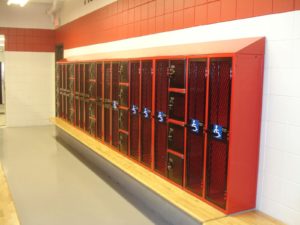Naturally, you only have so much space available in your location, and your geography will ultimately determine how large you can make your lockers. However, if you have space enough to build lockers to meet the needs of your people, here are some ways to choose just the right size for the purpose.
1) Hallways
 The standard size for hallway lockers has historically been 12” wide, 12” deep, 36” tall, and either two tiers or one tier. However, with the arrival of bigger backpacks and textbooks, we strongly recommend increasing the locker size to better accommodate belongings. Choose lockers that are 15” deep if your hallways are spacious enough or 15” wide if wall space is more available. Better yet, maximize in both directions with 15” by 15” lockers.
The standard size for hallway lockers has historically been 12” wide, 12” deep, 36” tall, and either two tiers or one tier. However, with the arrival of bigger backpacks and textbooks, we strongly recommend increasing the locker size to better accommodate belongings. Choose lockers that are 15” deep if your hallways are spacious enough or 15” wide if wall space is more available. Better yet, maximize in both directions with 15” by 15” lockers.
This extra roominess allows for students to better store belongings, but it also protects the locker from overcrowding. When backpacks and clothes are crammed into too small spaces, it can cause the latch to jam or bend the door, preventing it from working properly and making it possible for vandals to pry open the edge of the door.
Hallway lockers can be designed as a single tier or double tier, depending on the needs of the users. The extra length of a single-tier locker is very useful, especially in areas where boots and coats are frequently needed. Double tier lockers offer more individual spaces but make for awkward use when one student must bend down as the door above is opened
2) PE Rooms
 One of the most popular PE room choices is the run of 6-2-6 lockers, where six small lockers are stacked atop each other, next to two tall lockers, with another set of six stacked on the other side. This design lets students who are currently in gym class store their backpack and any other items they’ve brought in the larger lockers, then move any gym clothes or sneakers to the smaller lockers during their other class times.
One of the most popular PE room choices is the run of 6-2-6 lockers, where six small lockers are stacked atop each other, next to two tall lockers, with another set of six stacked on the other side. This design lets students who are currently in gym class store their backpack and any other items they’ve brought in the larger lockers, then move any gym clothes or sneakers to the smaller lockers during their other class times.
Other PE rooms install enough lockers for everyone, in sizes such as 12” wide and 30” deep, according to available space. Most high population schools simply don’t have the room, however, which makes alternative designs a good option.
Special note: Make sure that your PE lockers have plenty of ventilation!!! Everyone will thank you later!
3) Team Rooms
 Senior and junior varsity team rooms are often where open lockers are found, usually protected within secure rooms, which allows for greater ventilation. To maintain some individual security, buyers can request additional lockable compartments for the inside of the locker to keep a wallet and phone.
Senior and junior varsity team rooms are often where open lockers are found, usually protected within secure rooms, which allows for greater ventilation. To maintain some individual security, buyers can request additional lockable compartments for the inside of the locker to keep a wallet and phone.
Users of these rooms usually need a lot of hanging space to accommodate equipment, both for the wrestler and the football player. Bigger is usually better here, as quality lockers can boost morale and make the team feel as important as their winning lockers. Typically these will be 18” by 72”, and often feature a bench in front.
4) Staff Rooms
I n kitchens or employee break rooms, businesses often choose to install a short run of lockers for employees to keep their belongings in while on the job. Since clothes are often hung in these spaces, opt for single tiers that offer the needed length. 12” wide by 15-18” deep is recommended to allow plenty of room for hangers to rest without wrinkling clothes.
n kitchens or employee break rooms, businesses often choose to install a short run of lockers for employees to keep their belongings in while on the job. Since clothes are often hung in these spaces, opt for single tiers that offer the needed length. 12” wide by 15-18” deep is recommended to allow plenty of room for hangers to rest without wrinkling clothes.
Lockers can serve many purposes in a variety of different settings, and size can mean the difference between functional storage and frustrating shelf. Consider how to best use your available space and consult with the locker experts for more information on making the most of your new lockers in your old location.
Are you ready to start planning your locker transformation? DeBourgh Lockers is the premier source of quality lockers that can redefine your setting. Contact us to learn more.